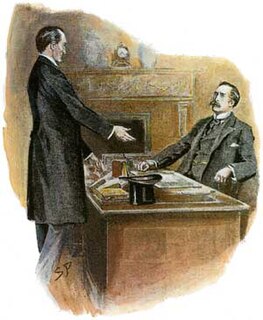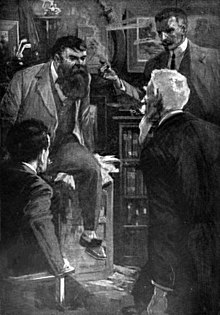
Sherlock Holmes is a fictional detective created by British author Sir Arthur Conan Doyle. Referring to himself as a "consulting detective" in the stories, Holmes is known for his proficiency with observation, deduction, forensic science and logical reasoning that borders on the fantastic, which he employs when investigating cases for a wide variety of clients, including Scotland Yard.

Scientific romance is an archaic, mainly British term for the genre of fiction now commonly known as science fiction. The term originated in the 1850s to describe both fiction and elements of scientific writing, but it has since come to refer to the science fiction of the late nineteenth and early twentieth centuries, primarily that of Jules Verne, H. G. Wells and Arthur Conan Doyle. In recent years the term has come to be applied to science fiction written in a deliberately anachronistic style as a homage to or pastiche of the original scientific romances.

George Edward Challenger is a fictional character in a series of fantasy and science fiction stories by Sir Arthur Conan Doyle. Unlike Conan Doyle's self-controlled, analytical character, Sherlock Holmes, Professor Challenger is an aggressive, hot-tempered, dominating figure.

The Lost World is a science fiction novel by British writer Arthur Conan Doyle, published by Hodder & Stoughton in 1912, concerning an expedition to a plateau in the Amazon basin of South America where prehistoric animals still survive. It was originally published serially in the Strand Magazine and illustrated by New-Zealand-born artist Harry Rountree during the months of April–November 1912. The character of Professor Challenger was introduced in this book. The novel also describes a war between indigenous people and a vicious tribe of ape-like creatures.

The Exploits of Sherlock Holmes is a short story collection of twelve Sherlock Holmes pastiches, first published in 1954. It was written by Adrian Conan Doyle, who was the son of Sir Arthur Conan Doyle, and by John Dickson Carr, who was the authorised biographer of the elder Conan Doyle. The first six stories were written in collaboration by the two writers, while the last six stories were written solely by Adrian Conan Doyle.
"When the World Screamed" is a science fiction short story by British writer Arthur Conan Doyle, featuring his character Professor Challenger. It was first published in Liberty magazine, from 25 February to 3 March 1928.

The Lost World is a 1925 American silent fantasy giant monster adventure film adapted from Arthur Conan Doyle's 1912 novel of the same name. The film was produced and distributed by First National Pictures, a major Hollywood studio at the time, and stars Wallace Beery as Professor Challenger. It was directed by Harry O. Hoyt and featured pioneering stop motion special effects by Willis O'Brien, a forerunner of his work on the original King Kong. Doyle appears in a frontispiece to the film, absent from some extant prints.

The Lost World is a syndicated television series loosely based on the 1912 novel by Sir Arthur Conan Doyle, The Lost World. Essentially, it was a series made with a big budget, which included production and actors from Canada, Australia and New Zealand. The show premiered in the United States in the fall of 1999. It ran for three seasons, the final two of which aired in syndication in the United States, before it was cancelled in 2002 after funding for a fourth season fell through. The final episode ended with an unresolved cliffhanger. All three seasons were released in DVD box sets in 2004.

The lost world is a subgenre of the fantasy or science fiction genres that involves the discovery of an unknown Earth civilization. It began as a subgenre of the late-Victorian adventure romance and remains popular into the 21st century.

The Land of Mist is a novel by British writer Arthur Conan Doyle, published in 1926.
"A Study in Emerald" is a short story written by British fantasy and graphic novel author Neil Gaiman. The story is a Sherlock Holmes pastiche transferred to the Cthulhu Mythos universe of horror writer H. P. Lovecraft. Gaiman describes it as "Lovecraft/Holmes fan fiction". It won the 2004 Hugo Award for Best Short Story. The title is a reference to the Sherlock Holmes novel A Study in Scarlet.

Traditionally, the canon of Sherlock Holmes consists of the 56 short stories and four novels written by Sir Arthur Conan Doyle. In this context, the term "canon" is an attempt to distinguish between Doyle's original works and subsequent works by other authors using the same characters.

The Lost World is a 1998 adventure film, loosely based on the 1912 novel of the same name by Arthur Conan Doyle. The film includes the characters, Professor George Challenger and Lord John Roxton, who also feature in Conan Doyle's other Doctor Challenger novels.

Sir Arthur Ignatius Conan Doyle was a British writer and physician. He created the character Sherlock Holmes in 1887 for A Study in Scarlet, the first of four novels and fifty-six short stories about Holmes and Dr. Watson. The Sherlock Holmes stories are milestones in the field of crime fiction.

King of the Lost World is a 2005 American giant monster adventure film produced by The Asylum. The film is adapted loosely from the 1912 novel The Lost World by Arthur Conan Doyle, the creator of Sherlock Holmes, but the film bears a closer resemblance to the remake of King Kong released in the same year, particularly as both stories center on a giant ape. Hence, King of the Lost World is a mockbuster of said film, a tradition that The Asylum usually undergoes.
Henry Burry Pullen-Burry was a British medical doctor best known as an occultist and author of the book Qabalism. He belonged to the famed occult group The Hermetic Order of the Golden Dawn, founded in London in 1888. The order taught and practised ceremonial magic, Qabalism, Rosicrucianism, and psychic arts such as astral projection, divination, astrology, etc.

Undershaw is a former residence of the author Sir Arthur Conan Doyle, the creator of Sherlock Holmes.

The Narrative of John Smith (2011) is a novel written in 1883 by Arthur Conan Doyle, published posthumously by The British Library. In a work of narrative fiction, Doyle writes from the perspective of a middle-aged bachelor named John Smith recovering from rheumatic gout. Unlike his later work in detective fiction, fantasy, and science fiction, this novel unfolds through a series of tangential, essay-like thoughts stemming from observations on everyday life. The subjects are of a “personal-social-political complexion”.
The year 1913 was marked, in science fiction, by the following events.

Zanthodon is a science fiction novel by American writer Lin Carter, the second in his series about the fictional "Hollow Earth" land of Zanthodon. It was first published in paperback by DAW Books in June 1980, with an ebook edition following from Gateway/Orion in October 2018. It was also gathered together with the other volumes in the series into the omnibus ebook collection The Zanthodon Megapack.

















